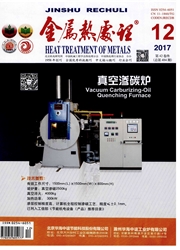

 中文摘要:
中文摘要:
采用脉冲电沉积法制备了单峰晶粒尺寸分布纳米晶镍,利用室温单向拉伸试验对比评价了电沉积粗晶镍、单峰晶粒尺寸分布纳米镍和双峰晶粒尺寸分布纳米镍的力学性能,并结合断口的TEM、SEM及数字图像法(DIC)分析揭示了其变形机制。结果表明,相对粗晶镍而言,纳米晶镍的抗拉强度显著提升,但断后伸长率显著降低,且其力学行为与晶粒尺寸分布有关。与单峰纳米镍相比,双峰分布纳米晶镍能够在保留高强度的同时显著提高其塑性。平均晶粒尺寸为51.2nm的双峰纳米镍抗拉强度较平均晶粒尺寸为19.3nm的单峰纳米镍抗拉强度仅降低15MPa,而断后伸长率却提高了2.2倍。双峰纳米镍的变形过程随着应变的增大逐渐由位错滑移机制为主导向晶界滑移、扩散机制为主导转变,最终引起局部剪切带的形成并导致材料的软化与断裂。
 英文摘要:
英文摘要:
The nanocrystalline Ni with unimodal grain size distribution was prepared by pulse electrodeposition method. The mechanical properties of the electrodeposition coarse crystalline Ni, the unimodal grain size distribution nanocrystalline Ni and the bimodal grain size distribution nanocrystalline Ni were comparatively evaluated with the simple tension tests at room temperature. The deformation mechanisms were discussed based on the TEM, SEM and digital image correlation method (DIC) analysis of the fracture. Results show that the tensile strength of nanocrystalline Ni increases significantly while the ductibility decreases significantly compared with those of the coarse crystalline Ni. Moreover, the grain size distribution has great effects on the mechanical behaviors of the nanocrystalline Ni. The bimodal grain size distribution nanocrystalline Ni with mean size of 51.2 nm has excellent tensile strength as well as enhanced ductibility in comparison with the unimodal grain size distribution nanocrystalline Ni with mean size of 19.3 nm. The corresponding tensile strength only decreases by 15 MPa while the percentage elongation after fracture increases 2.2 times. The dominant deformation mechanism of the bimodal grain size distribution nanocrystalline Ni changes from the dislocation gliding process to the grain-boundary sliding and diffusion process with the increase of strain. As a result, the local shear zones are induced and lead to the softening and fracture of the materials.
 同期刊论文项目
同期刊论文项目
 同项目期刊论文
同项目期刊论文
 期刊信息
期刊信息
